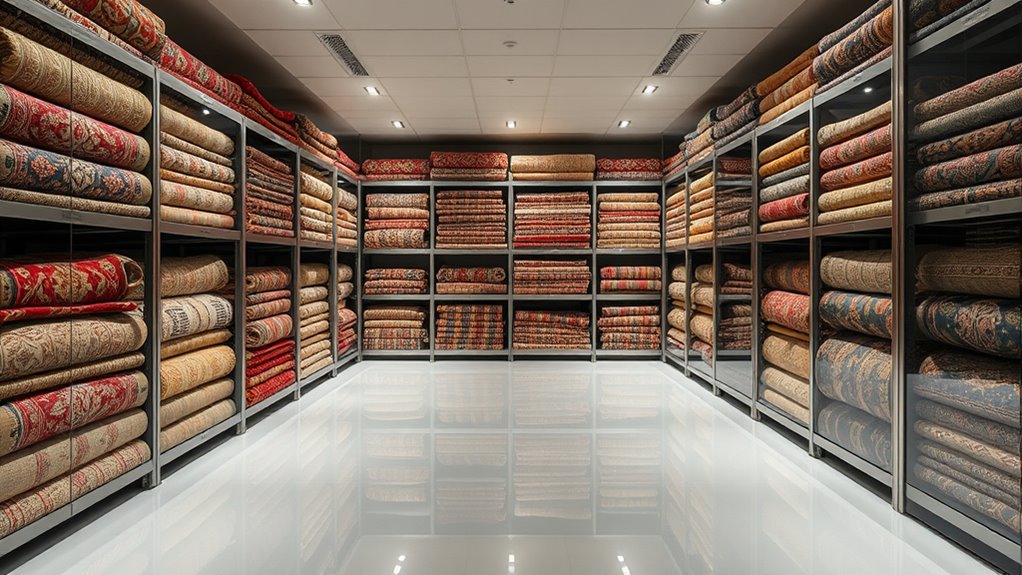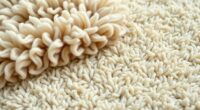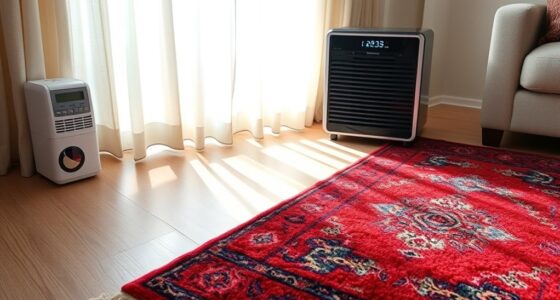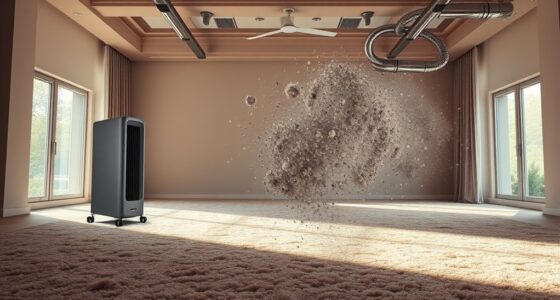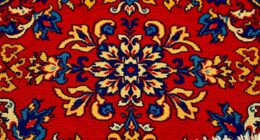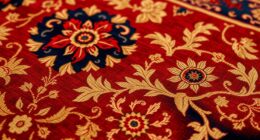To guarantee your antique carpets stay their best, you need a climate-controlled storage space that maintains stable temperature between 60-70°F and humidity levels between 45-55%. Proper environmental management helps prevent mold, pests, fading, and fiber deterioration. Use advanced systems with sensors to monitor conditions continuously and implement careful handling and storage practices. Staying compliant with these guidelines can protect your carpets long-term; if you keep exploring, you’ll discover more essential preservation techniques.
Key Takeaways
- Maintains stable temperature (60-70°F) and humidity (45-55%) to prevent fiber stress and deterioration.
- Uses advanced climate control systems and sensors for precise regulation and continuous environmental monitoring.
- Protects against mold, pests, and fading by minimizing light exposure and controlling airborne contaminants.
- Employs proper storage materials, like acid-free wraps, and careful handling to preserve antique integrity.
- Ensures secure, specialized environments with professional oversight for long-term preservation of antique carpets.
Understanding the Importance of Controlled Environments for Antique Carpets
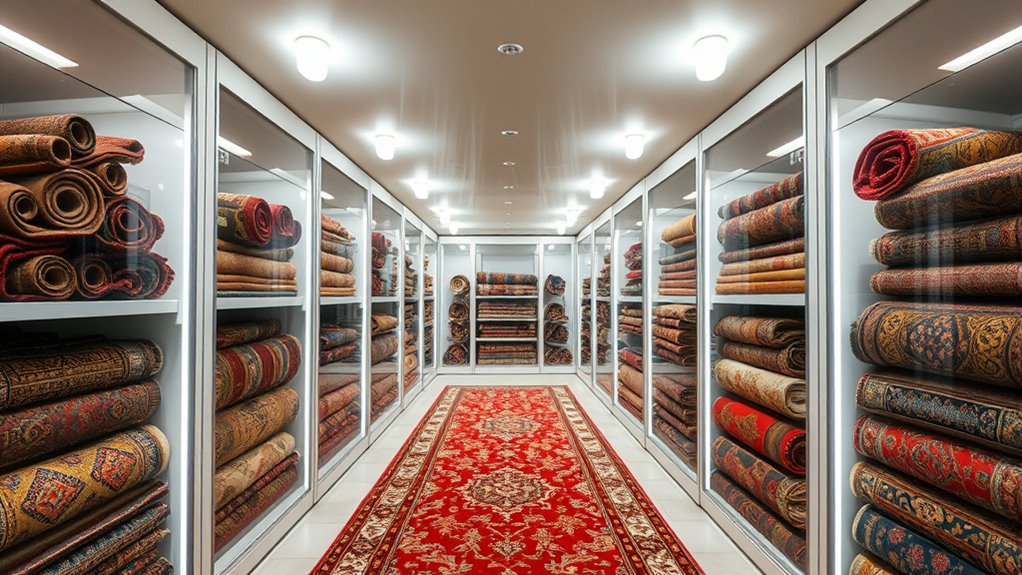
Antique carpets are valuable and delicate artifacts that require careful preservation. Maintaining a controlled environment helps protect their historical authenticity and aesthetic value. Fluctuations in temperature and humidity can cause fibers to weaken, colors to fade, and fibers to warp, compromising the carpet’s original character. When you guarantee a stable climate, you preserve the intricate details and craftsmanship that define these textiles. Proper climate control minimizes the risk of mold, pests, and deterioration, allowing the carpet to retain its beauty and historical significance for generations. Implementing climate control techniques is essential for maintaining the integrity of these textiles. Additionally, employing monitoring systems can help detect and respond promptly to environmental fluctuations, further protecting your investment. Understanding and maintaining optimal conditions is vital to prevent fiber degradation, and incorporating preventive measures can greatly enhance the longevity of your antique carpets. These practices ensure that the textiles remain in pristine condition for future generations to appreciate.
Key Environmental Factors Affecting Carpet Preservation

To preserve your antique carpets, you need to pay attention to a few key environmental factors. Keeping humidity levels stable helps prevent mold and deterioration, while consistent temperature avoids stress on the fibers. Additionally, minimizing light exposure protects the colors and intricate designs from fading over time. Implementing climate-controlled storage solutions can further optimize these conditions and ensure long-term preservation. Utilizing data analytics can help monitor environmental conditions continuously, ensuring optimal storage environments. Regularly checking for signs of spoilage or damage allows for timely intervention, maintaining the carpet’s integrity over the years. Incorporating self watering plant pots principles can also be adapted to regulate moisture levels within storage spaces, providing another layer of environmental control. Notably, automotive tuning techniques demonstrate how precise adjustments can optimize performance, similar to fine-tuning storage conditions for delicate textiles.
Humidity Control Stability
Maintaining stable humidity levels is essential for preserving antique carpets, as fluctuations can cause fibers to expand, contract, and weaken over time. Sudden changes can lead to irreversible damage, making humidity control stability vital during antique carpet restoration and textile artifact cataloging. To guarantee consistent conditions, consider these factors:
- Use humidifiers and dehumidifiers with precise controls to maintain an ideal range.
- Regularly monitor humidity levels with digital hygrometers for immediate adjustments.
- Avoid exposure to external environmental shifts, such as open windows or HVAC fluctuations.
- The type of home security system in place can also influence environmental stability, ensuring proper climate control measures are maintained.
Temperature Regulation Consistency
Consistent temperature regulation is vital for preserving the integrity of antique carpets, as fluctuations can cause fibers to expand and contract, leading to deterioration over time. When temperatures vary, it stresses the fibers, making them more vulnerable to damage and pest activity. Reliable climate control systems maintain steady temperatures, preventing these issues. Good air filtration is also essential, as it reduces dust, mold spores, and other airborne contaminants that can accelerate fiber breakdown. Additionally, stable temperatures discourage pests like moths and beetles, which thrive in fluctuating environments. Implementing proper humidity control is equally important, as humidity fluctuations can also damage fibers and promote mold growth. Maintaining air quality through consistent environmental controls helps prevent long-term damage and preserves the beauty and value of antique carpets. Ensuring temperature stability is crucial, as it minimizes fiber stress, reduces pest risks, and extends the lifespan of your antique carpets, preserving their beauty and value for generations. Regular monitoring of climate conditions can further enhance preservation efforts, ensuring optimal storage environments. Moreover, understanding the environmental factors involved in storage can help in selecting the right climate-controlled solutions for delicate textiles.
Light Exposure Minimization
While steady temperature regulation keeps your antique carpets safe from damage, controlling light exposure is equally important. Excessive light, especially UV rays, accelerates fading and weakens fibers. To minimize light damage, consider these steps:
- Use UV-protective filters on windows or install UV-blocking window films.
- Keep carpets covered with opaque fabrics or display cases when not in use.
- Limit exposure time by rotating carpets periodically, reducing prolonged UV contact.
- Be aware that light exposure is a key environmental factor affecting carpet preservation.
- Proper storage conditions, including light management, are essential for maintaining the integrity of antique carpets over time.
Designing Climate-Controlled Storage Spaces
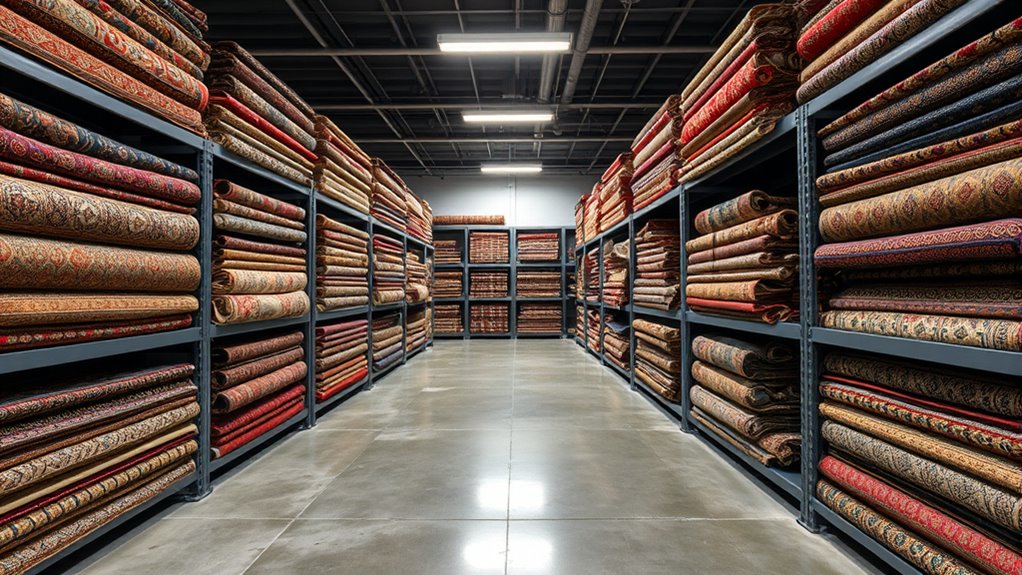
Designing climate-controlled storage spaces requires careful planning to protect antique carpets from environmental damage. You should consider antique carpet design and weaving techniques to guarantee proper storage. For example, understanding the materials used in different carpets helps you choose suitable padding and shelving that won’t cause deterioration. Avoid placing carpets directly on concrete floors or against walls, which can lead to uneven air circulation and potential damage. Use breathable, acid-free storage materials that support the weaving structure without trapping moisture. Incorporate adjustable shelving to accommodate various sizes and facilitate easy inspection. Proper lighting, ventilation, and secure access are also essential. By integrating knowledge of antique carpet design and weaving techniques, you create a storage environment that preserves your carpets’ integrity for generations.
Temperature and Humidity Guidelines for Antique Carpets

Maintaining proper temperature and humidity levels is essential for preserving antique carpets, as fluctuations can cause fibers to expand, contract, or become brittle over time. Consistent conditions help protect the carpet’s fiber analysis and maintain its historical significance. To achieve this, aim for a temperature range of 60-70°F (15-21°C) and relative humidity between 45-55%.
Consistent temperature (60-70°F) and humidity (45-55%) protect antique carpets’ fibers and preserve their historical value.
- Avoid rapid changes in temperature and humidity, which can stress fibers.
- Use hygrometers and thermostats to monitor conditions closely.
- Consider the carpet’s origin and materials, as some fibers are more sensitive to fluctuations.
Benefits of Using Advanced Climate Control Technologies
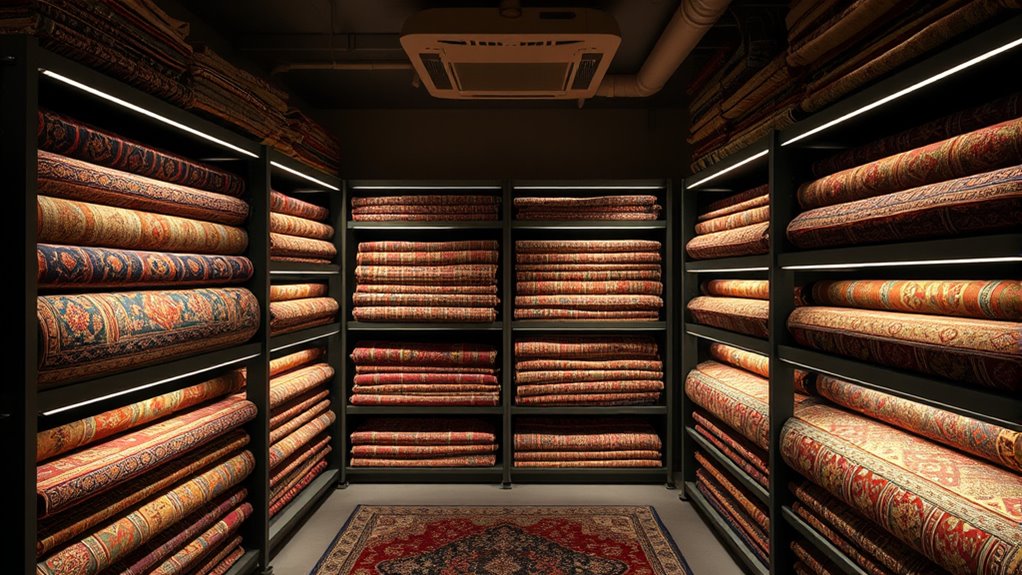
Advanced climate control technologies offer precise regulation of temperature and humidity, ensuring consistent conditions that are critical for preserving antique carpets. These systems help prevent damage during antique rug restoration and maintain ideal conditions for vintage carpet appraisal. By controlling environmental factors, you reduce risks like mold, pests, and fiber deterioration. Investing in advanced climate control also extends the lifespan of your carpets, preserving their value and beauty. Here’s a quick overview:
| Benefit | Description | Example Use |
|---|---|---|
| Consistent Conditions | Maintains stable environment | During long-term storage |
| Damage Prevention | Reduces mold, pests, and fiber decay | In antique rug restoration |
| Value Preservation | Protects carpet’s appearance and worth | For vintage carpet appraisal |
Monitoring and Maintaining Optimal Conditions
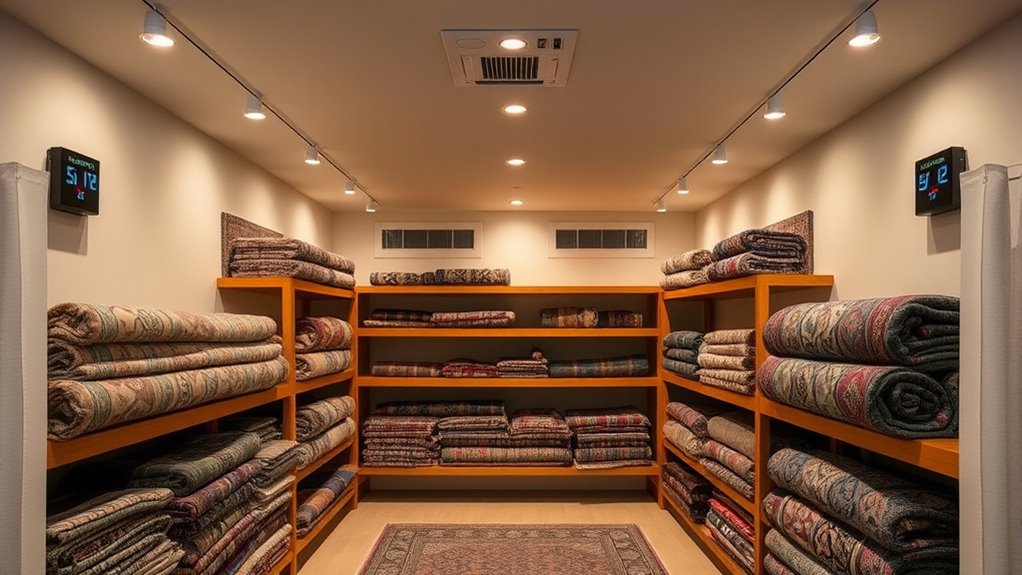
You need to keep the storage environment stable, especially regarding temperature, to prevent damage to your antique carpets. Humidity control strategies help avoid mold and deterioration, so monitoring moisture levels is essential. Regular condition checks ensure you catch issues early and maintain ideal conditions for preservation.
Temperature Stability Importance
Because antique carpets are highly sensitive to environmental fluctuations, ensuring temperature stability is essential for their preservation. Fluctuating temperatures can cause fibers to expand and contract, leading to damage over time. To maintain ideal conditions, you should:
- Regularly monitor temperature levels with reliable sensors to detect shifts early.
- Avoid rapid temperature changes during antique carpet cleaning, which can weaken fibers.
- Understand that traditional carpet weaving techniques often use delicate materials that require consistent warmth and coolness to prevent deterioration.
Maintaining a stable temperature also helps preserve the intricate dye patterns and prevents color fading. By controlling temperature, you protect the carpet’s integrity and historical value, ensuring it remains a beautiful artifact for generations.
Humidity Control Strategies
Effective humidity control is essential for preserving antique carpets, as fluctuations can lead to mold growth, fiber deterioration, and color bleeding. To achieve this, you should regularly monitor humidity levels with reliable hygrometers, ensuring they stay between 45-55%. Using dehumidifiers or humidifiers helps maintain consistent conditions, especially considering regional climate impacts that can cause moisture swings. Pay close attention to antique carpet dyes, which may fade or bleed if humidity is too high or too low. Proper storage environments should be well-sealed and insulated to prevent sudden changes. Consistent monitoring allows you to respond promptly to humidity shifts, protecting the carpet’s integrity and vibrant colors over time. This strategic approach minimizes risks associated with environmental fluctuations, safeguarding your antique carpets effectively.
Regular Condition Monitoring
Maintaining ideal conditions for antique carpets requires consistent and thorough monitoring of their environment. Regular condition monitoring helps prevent damage, ensuring your carpets retain their beauty and value. It’s essential to check for signs of deterioration, such as fading or fraying, which may indicate environmental issues. Incorporate advanced sensors to track temperature, humidity, and light exposure, especially if your collection features modern design influences or requires antique carpet restoration.
Consider these key practices:
- Schedule routine inspections to catch problems early.
- Use digital monitoring tools for real-time data.
- Adjust climate controls promptly based on findings.
Handling and Preparing Carpets for Storage

Before storing antique carpets, you should carefully clean and inspect them to prevent damage and preserve their value. Gently vacuum the surface, avoiding harsh bristles that could harm delicate antique carpet dyes. Check for any tears or weak spots to address before storage. When handling, use proper carpet stacking techniques to prevent crushing or distortion. Store the carpet flat if possible, or roll it loosely, avoiding tight folds. Keep in mind that improper stacking can damage fragile dyes and fibers. Use acid-free tissue paper around edges for added protection. The table below highlights key handling tips:
| Tip | Explanation |
|---|---|
| Gentle Cleaning | Prevents dye bleeding and fiber damage |
| Proper Support | Avoids distortion and crushing |
| Loose Rolling | Protects antique dyes and fibers |
| Padding with Tissue Paper | Shields edges from wear |
| Monitoring Post-Storage | Ensures early detection of deterioration |
Choosing the Right Storage Facility for Antique Carpets

Choosing the right storage facility is essential to preserving the beauty and value of your antique carpets. A proper facility safeguards against damage and maintains their cultural significance. When selecting a storage location, consider these key factors:
- Climate control to prevent deterioration and support antique carpet repairs if needed.
- Security measures that protect your investment from theft or vandalism.
- Proven expertise in handling antique textiles, ensuring they’re stored with care and respect for their cultural significance.
A specialized storage facility not only preserves your carpets’ integrity but also allows for proper maintenance, including repairs when necessary. Avoid facilities that lack climate control or experience with antique carpets, as improper storage can diminish your carpet’s value and historical importance.
Long-Term Preservation Strategies and Best Practices

To guarantee your antique carpets remain in pristine condition for generations, implementing long-term preservation strategies is essential. Recognize their historical significance and cultural symbolism, which make them invaluable artifacts. Store carpets in climate-controlled environments with stable temperature and humidity levels, preventing deterioration from fluctuations. Use acid-free materials for wrapping and support to avoid chemical damage over time. Regularly inspect your carpets for signs of pests or wear, addressing issues immediately. Avoid exposure to direct sunlight, which can fade dyes and weaken fibers. Proper handling and minimal movement help preserve their integrity. By following these best practices, you safeguard not only their beauty but also their cultural and historical importance for future generations to appreciate.
Frequently Asked Questions
How Often Should Climate Conditions Be Checked in Storage Facilities?
You should check climate conditions regularly to maintain ideal storage. Follow storage temperature guidelines closely, ideally monitoring temperature and humidity levels at least once a week. Consistent humidity monitoring frequency helps prevent damage from mold or pests. By staying vigilant and adjusting settings as needed, you ensure your antique carpets stay in perfect condition, avoiding deterioration caused by environmental fluctuations. Regular checks are essential for long-term preservation.
What Are the Common Mistakes to Avoid in Climate-Controlled Storage?
Think of your storage like a delicate orchestra; harmony depends on avoiding discord. You should steer clear of common mistakes like ignoring humidity fluctuations and neglecting proper ventilation. These errors can cause damage over time, like a discordant note disrupting the symphony. Regularly monitoring conditions guarantees your antique carpets stay preserved in perfect balance, preventing deterioration due to moisture buildup or stale air. Stay vigilant, and your treasures will remain timeless.
Can Climate Control Prevent Pest Infestations in Antique Carpets?
Climate control alone doesn’t guarantee pest prevention for antique carpets, but it plays a key role in storage environment enhancement. By maintaining consistent humidity and temperature, you reduce conditions that pests thrive in. Combine this with pest deterrent strategies like regular inspections and proper cleaning. This holistic approach considerably lowers the risk of pest infestations, ensuring your carpets stay safe and preserved in ideal conditions.
How Does Lighting Affect the Preservation of Stored Carpets?
Lighting impact plays a significant role in the preservation effects of stored carpets. You should avoid direct sunlight and harsh artificial light, as exposure can cause fading and deterioration of fibers over time. Using low, indirect lighting helps safeguard colors and materials, maintaining the carpet’s beauty and integrity. By controlling lighting conditions, you ensure your antique carpets stay vibrant and well-preserved for years to come.
What Are the Costs Associated With Maintaining Climate-Controlled Storage?
Managing climate-controlled storage costs is like balancing a delicate dance. You’ll need to budget for storage unit insurance to protect your valuable carpets and monitor energy consumption to keep conditions stable. These expenses can add up, but they’re essential for preservation. While costs vary, expect monthly fees for the space, insurance premiums, and the energy needed to maintain precise temperature and humidity levels, ensuring your antiques stay pristine.
Conclusion
Think of climate-controlled storage as a gentle guardian for your antique carpets, preserving their beauty like a timeless treasure. By carefully managing temperature, humidity, and handling, you guarantee they stay vibrant and intact for generations to come. With the right environment, your carpets can endure like a well-loved family heirloom, revealing their rich history and craftsmanship. Embrace advanced storage solutions to keep your antique carpets safe, beautiful, and timeless—just like they deserve to be.
